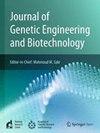In-Silico discovery of novel cephalosporin antibiotic conformers via ligand-based pharmacophore modelling and de novo molecular design
IF 2.8
Q3 Biochemistry, Genetics and Molecular Biology
Journal of Genetic Engineering and Biotechnology
Pub Date : 2025-06-03
DOI:10.1016/j.jgeb.2025.100514
引用次数: 0
Abstract
Antibiotic resistance poses a significant global challenge as bacteria evolve in response to antibiotic use, leading to prolonged hospitalizations, increased healthcare costs, and higher mortality rates. Cephalosporins, a class of beta-lactam antibiotics, are commonly employed to manage infections; however, their misuse and overuse have contributed to resistance development. In response, in silico methods have emerged as cost-effective and efficient tools for drug discovery. This research aims to predict new compounds using ligand-based pharmacophore models while optimizing existing drugs. We employed a de novo approach to synthesize models of cephalosporin structural motifs, integrating the β-lactam core with potential antibiotic candidates. A shared features pharmacophore (SFP) model was constructed using cephalosporins from PubChem, including cephalothin, ceftriaxone, and cefotaxime. The model comprises hydrogen bond acceptors, hydrogen bond donors, aromatic rings, hydrophobic regions, and negatively ionizable sites. Its robustness was evidenced by a goodness-of-hit (GH) score of 0.739. The generated pharmacophore model, with a score of 0.9268, was utilized to screen a drug library, initially assessing 19 compounds. After the drug-likeness screening, seven promising compounds were identified. These candidates were then fused with the cephalosporin core using genetic algorithms and fragment-based design, resulting in 30 novel synthetic models. Most of these models demonstrated a cephalosporin core, over 70 % average similarity, a TPSA (NO) ≤ 99.85 Å2, a drug-likeness (QED) ≥ 0.6, and a Synthetic Accessibility Score (SAScore) ≤ 4.3. Molecular docking and MD simulation evaluations highlighted two candidates—Molecule 23 and Molecule 5, demonstrating superior binding affinities to Penicillin-binding protein 1a (PDB ID: 2V2F) compared to controls. To ensure feasible synthesis, molecular architecture comparison and computational retrosynthesis were performed, confirming the likelihood of successful laboratory synthesis. These findings advance the fight against antimicrobial resistance by establishing a method for designing new, highly effective antibiotic drugs.
通过基于配体的药效团建模和从头分子设计,在硅中发现新的头孢菌素抗生素构象
抗生素耐药性是一个重大的全球性挑战,因为细菌在抗生素使用的反应中进化,导致住院时间延长,医疗费用增加,死亡率更高。头孢菌素是一类β -内酰胺类抗生素,通常用于控制感染;然而,它们的误用和过度使用导致了耐药性的发展。因此,计算机方法已成为药物发现的成本效益高、效率高的工具。本研究旨在利用基于配体的药效团模型预测新化合物,同时优化现有药物。我们采用了一种新的方法来合成头孢菌素结构基序模型,将β-内酰胺核心与潜在的候选抗生素结合起来。使用PubChem中的头孢菌素(包括头孢素、头孢曲松和头孢噻肟)构建共享特征药效团(SFP)模型。该模型包括氢键受体、氢键供体、芳香环、疏水区域和负电离位点。其稳健性由命中优度(GH)得分为0.739证明。生成的药效团模型得分为0.9268,用于筛选药物文库,初步评估了19个化合物。经过药物相似性筛选,鉴定出7种有前景的化合物。然后使用遗传算法和基于片段的设计将这些候选药物与头孢菌素核心融合,产生30个新的合成模型。这些模型大多具有头孢菌素核心,平均相似度超过70%,TPSA (NO)≤99.85 Å2,药物相似度(QED)≥0.6,综合可及性评分(SAScore)≤4.3。分子对接和MD模拟评估突出了两个候选分子-分子23和分子5,与对照相比,它们与青霉素结合蛋白1a (PDB ID: 2V2F)具有更好的结合亲和力。为了确保合成的可行性,进行了分子结构比较和计算反合成,确认了实验室合成成功的可能性。这些发现通过建立一种设计新型高效抗生素药物的方法,推进了与抗菌素耐药性的斗争。
本文章由计算机程序翻译,如有差异,请以英文原文为准。
求助全文
约1分钟内获得全文
求助全文
来源期刊

Journal of Genetic Engineering and Biotechnology
Biochemistry, Genetics and Molecular Biology-Biotechnology
CiteScore
5.70
自引率
5.70%
发文量
159
审稿时长
16 weeks
期刊介绍:
Journal of genetic engineering and biotechnology is devoted to rapid publication of full-length research papers that leads to significant contribution in advancing knowledge in genetic engineering and biotechnology and provide novel perspectives in this research area. JGEB includes all major themes related to genetic engineering and recombinant DNA. The area of interest of JGEB includes but not restricted to: •Plant genetics •Animal genetics •Bacterial enzymes •Agricultural Biotechnology, •Biochemistry, •Biophysics, •Bioinformatics, •Environmental Biotechnology, •Industrial Biotechnology, •Microbial biotechnology, •Medical Biotechnology, •Bioenergy, Biosafety, •Biosecurity, •Bioethics, •GMOS, •Genomic, •Proteomic JGEB accepts
 求助内容:
求助内容: 应助结果提醒方式:
应助结果提醒方式:


